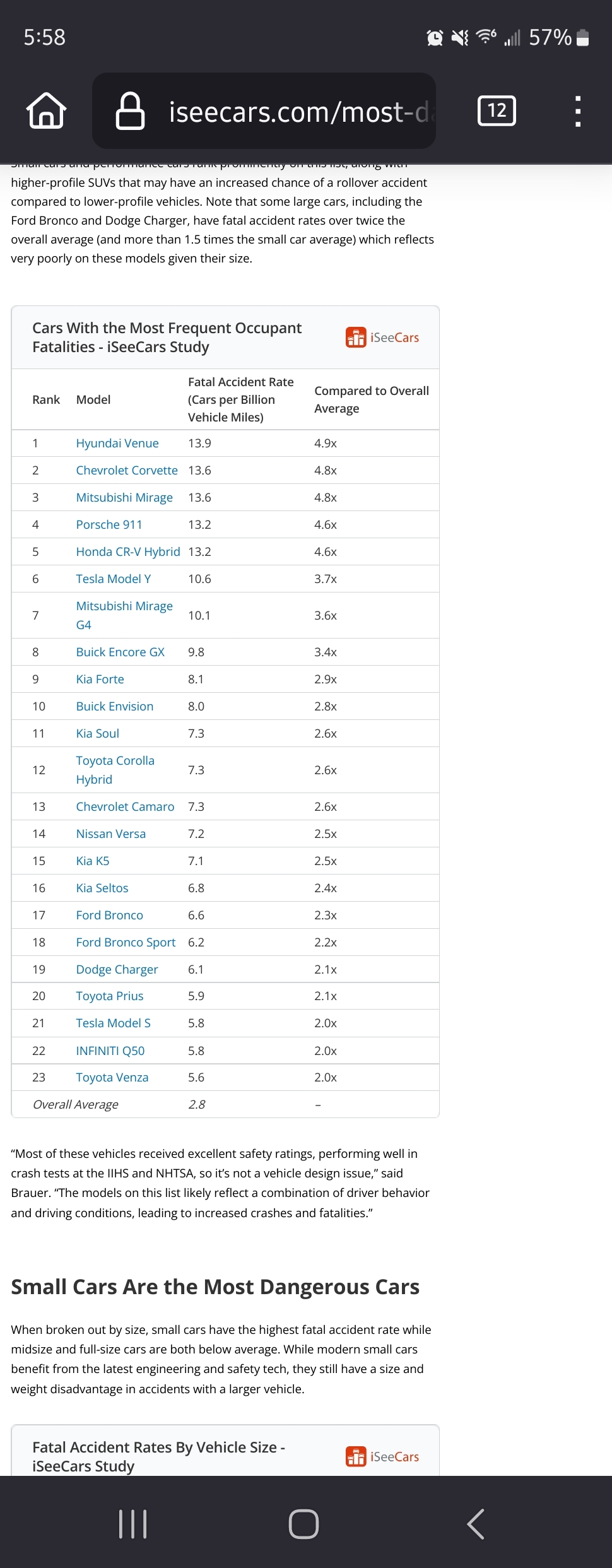Automotive research firm finds that Tesla has higher frequency of deadly accidents than any other car brand
But all they did was market their pretty good lane-assist and automated braking as a magic butler that lets you nap in the driver’s seat.
How could this happen??
Makes sense to me, most people who own them seem to drive like jackasses.
To be fair most of them are in California and Californians are the worst drivers in the country.
To be fair, California is not even close to having the worst drivers.
https://www.forbes.com/advisor/car-insurance/worst-drivers-by-state/
Different definitions of worse. Texas is basically one giant DUI, so… Yeah, worse. But also when sober they’ll drive circles around the average California driver.
Which is odd, because most electric vehicles (including some models of the Tesla) have better crash ratings due to having a crumple zone where the engine would be. Assuming that’s still true, there must be another factor that tips the balance towards deadly accidents. Some thoughts:
- They are heavy cars. Maybe it’s safer for the passengers but more deadly for the other vehicle.
- Maybe Tesla drivers are more irresponsible than other car owners.
- Maybe the torque and acceleration is too high, causing people to lose control more often.
- Maybe something that doesn’t get rated in the crash ratings causes deaths, eg. electric locks which are unable to open when power is lost, a likely scenario during collisions.
- Maybe the FSD features are causing more collisions to happen.
Maybe Tesla drivers are more irresponsible than other car owners.
That was going to be my suggestion.
If there’s a systemic reason Tesla drivers have more accidents in a Tesla than drivers of other cars, that car is inherently less safe.
You can’t simply put it down to “Tesla drivers suck”, that’s irresponsible and flawed logic.If it’s the acceleration, maybe we shouldn’t have cars that accelerate the way a Tesla can. But I very much doubt that is the reason except anecdotally. I suspect more that safety features may in fact serve to distract, or people “learn” to rely on them, and than they turn out to not be 100% reliable.
We’ve all heard the weird tendency of Tesla breaking for no reason, that is hazard, also the turn signals are placed wrong, causing them to be impractical in some situations like roundabouts. Also the instrumentation in general of a Tesla is centered very much around the touch screen, another source of potential distraction. AFAIK even the speedometer isn’t placed where it should be to observe it quickly without looking away from the road for too long.
A lot of inherent safety feature in traditional cars, have been shaved away in Tesla cars. Even getting out in an emergency can be a problem, as the handles may fail because they are electric, and the “real” handles are hidden.
There a dozens of examples where Tesla is designed for less safety than traditional cars, and if (when) the safety features fail, I bet they are a lot less safe than if those features weren’t there to begin with.
Tesla cars are designed with a VERY strong focus on reducing production cost, Elon Musk is even boasting about it, and how he has an uncompromising goal to simplify production. But Tesla also lack the experience about why things are like they are in traditional cars.
The systemic reason might just simply be “They were the kind of a person that would buy a Tesla”.
If I wanted to buy a safe car to drive responsibly while respecting all the traffic rules, an EV with almost a thousand horses with a 0-60 time of 2.1-2.4 seconds wouldn’t exactly be my first choice.
When this was posted last week, I mentioned that it was odd that all the most deadliest models on the list were all low production cars, meaning there might be something wonky with their methodology.
There was a similar “study” done a year or so ago where they simply looked at car insurance applications and used people’s accident history and whatever vehicle they were trying to insure at the time to generate a list of which models had the “most accidents” in an incredibly flawed manor (Pontiac and Oldsmobile were among the safest even though neither company exists anymore).
The data is by “Fatal Accident Rate (Cars per Billion Vehicle Miles)”, Model Y having 10.6, Model S having 5.8. Ignoring Model 3, the average would be 8.2. Back in 2023 Tesla tweeted “Total miles driven by the Tesla fleet has exceeded 100 billion miles globally—equal to 532 round trips to the sun!”
So that math says 820 fatal accidents, Tesladeaths reports 614. I’d say the numbers seem close enough?The study said they normalize by mileage, which will account for both model popularity and driving distance. Driving safety is usually reported in incidents per mile or something to that effect, so that’s all standard.
Last time I looked up publicly available crash statistics in the US and calculated the per-maker numbers, Tesla was like 1/80th the typical per capita crashes of the average auto maker. That was a few years back, but I doubt that’s changed without some sketchy statistic interpretations.
Obligatory preface written after comment was written:
I am in no way a statistician or data analysis guru. I admit I could be looking at this shit entirely wrong and welcome anybody who corrects anything I I’m looking at incorrectly.
Actual comment:
The entire report itself is skewed as fuck before Rolling Stone cherry picked the fuck out of it for the article to slam Tesla. Listen I’m as sick of Elon as the next but these fucking shit on everything Elon hiveminds are so much more fucking obnoxious. Theyre always 10 to 1 comments by people who didnt read the article to comments by people who did.
At the end is the actual image from the site that issued the report. I didnt bother with a source link because it’s right in the article OP posted.
Issues with the article and report:
-
The figures are not for every car on the road it only covers cars made between 2018 and 2022. Not a big deal but still deceiving as fuck to theme the article as Tesla has one of the highest death rates. Cuz they left the time frame out of the RS article. Kinda how they left out the fact that only 1 tesla is in the top 6 and the other Tesla is second to last with a flood of much larger much more common vehicle names that fill in between 1 and 23.
-
Each rate is calculated off 1 billion miles driven per year. When you put any Tesla model up next to any Ford, Honda, GM, Toyota, etc the % of all teslas on the road are going to be ridiculously higher than the % of the other much larger industry makes and models on the road that it takes to reach 1 billion miles. Because idk if I explained that well here is a made up scenario to illustrate it. Let’s say there are 1000 teslas on the road compared to 1,000,000 Prius on the road. The tesla death rates are based out of 1000 Teslas driving 1,000,000 miles each. Whereas the Prius death rates are based off 1,000,000 Prius’ driving 1,000 miles each.
-
Remember point 2 as it plays into point 3. The method they used to calculate the rate outlined in point 2, I believe is normal when govt is figuring out vehicle death rates by category, location, driver age, etc. However the study they reference is specifically for death rates per vehicle make. Which makes the methods used for calculating deathrate by make and model completely fucked. They should’ve done the same number of cars per each make and model type as well as the same miles driven to get a comparable outcome of death rates per make amd model over 4 year span.

-
i hadn’t ever thought about how the headlights having space between themselves on cars really helped judge how far a vehicle was and how fast it is moving toward me.
that is nigh impossible to judge with the teslas with the unibrow lights when moving in the dark.
New VW vehicles also have this. Seems to be the new thing
I work as a valet driver and the Tesla - unlike any other car including the newer EVs from other brands - seems like it was designed by people who have never driven a car. Ever.
Call me crazy but having nearly all the controls in a stupid idiotic touch screen where you have to scroll through multiple menus for basic car settings is a terrible idea. And so is braking by letting off the gas.
And the people who buy them tend to be a certain kind of person… not the brightest
No way bro, single pedal driving is amazing. There’s also voice commands and you can hotkey stuff to the left scroll wheel (I use it for toggling chill/performance mode), and you can put it in autopilot if you really gotta use the touchscreen - but how often do you need to do something not covered by voice commands steering buttons?
No way bro, single pedal driving is amazing.
What’s amazing about it? Seems
intuitiveunintuitive as hell but I’ve never actually experienced it personally. How do you control how fast you stop or just coast? What if the electronics fail? My car the brakes are mechanically connected to the pedal, if the power brakes go out I can still brake without them (although it is much more difficult).edit: that was supposed to say UNintuitive
I have a Mach-E and drive exclusively in one pedal mode. With my car you can still use the brake if you want. But honestly once you adjust to it, it becomes very instinctive to let it accelerate and decelerate based on the traffic patterns around you.
Now, if someone’s doing some stupid shit in Seattle during rush hour traffic I end up using the brake more but for 95% of my daily driving I’m just using the one pedal.
It’s honestly more jarring going back to driving my truck with a traditional setup than it was adjusting to the one pedal setup.
Like a lot of things about cars today (your bright-ass lights, size making it impossible to see around you, that fucking beeping) this is annoying for those around you because the brake lights don’t go on your car just suddenly decelerates.
If you’re reading the brake lights on the car directly in front of you as an indicator to slow down, you have already lost the plot.
A competent driver is actively driving a minimum of half a mile ahead of themselves with more than adequate distance between the vehicle directly in front of them to allow a response to changing road conditions.
The car doesn’t suddenly decelerate unless the driver completely pulls their foot from the pedal. This sounds like a skill issue on both sides.








